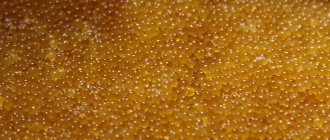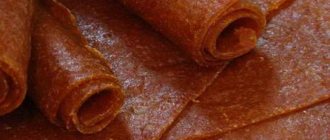An amazing, unusual and amazing delicacy is caviar. Its aftertaste is unique and exquisite. Pike, red, sturgeon... It literally melts in your mouth, exploding with salty juice. The bright taste also matches the beneficial properties. Caviar is considered a dietary product and is a source of vigor and life-giving energy. Caviar prepared at home is much healthier and tastier than store-bought caviar. And if there are avid fishermen at home, you can prepare the delicacy yourself. But before delving into cookbooks, caviar needs to be cleaned of film.
Features of fish caviar: red and black
We are accustomed to considering caviar only from the point of view of its taste. Not a single holiday, not a single celebration is complete without canapes with caviar, Maslenitsa - without pancakes with such filling. Meanwhile, caviar also has properties that are beneficial for the human body. For example, more than 30% of the composition of caviar is made up of proteins of the highest quality. Polyunsaturated fatty acids are easily absorbed by our body and make an invaluable contribution to health. Thanks to them, cholesterol levels in the blood are reduced, which prevents the occurrence of diseases such as atherosclerosis, heart attack, and stroke. Phosphorus, calcium, magnesium, iodine and other trace elements - all of them are contained in small eggs and are simply necessary for humans.
Because of its rich composition, caviar is sometimes called “living energy.” In addition, it is able to regenerate processes in our body and increase hemoglobin levels. This helps improve blood circulation and improves immunity.
But everything is good in moderation. In small quantities, caviar is really useful. But we should also talk about who should not abuse the delicacy. People with coronary heart disease, hypertension and urolithiasis should be careful not to include caviar in their menu. And the reason for this is the large amount of salt contained in the product.

Caviar is very beneficial for the body
Possible causes of fullness in calves
Before you run to the gym or start exhausting yourself with a diet, you need to understand the reasons for this obesity. So, let's begin:
The calves on the legs may be voluminous due to the presence of edema
. You don't know how to determine if you have swelling? All you have to do is take off your socks and look at the ankles of your feet. Are there rubber marks on them? This is an undoubted consequence of developed edema.
Another evidence of the presence of edema can be a problem with putting on shoes: if the shoes that you put on without problems in the morning suddenly become tight for you in the evening.
Another simple way to determine swelling: press your finger on the leg in the place where dry bone appears. If the soft tissues of the leg immediately smooth out, there is no swelling; the remaining hole indicates the presence of edema.
How to deal with swelling
- The surest remedy for edema is following a diet that prohibits fatty and salty foods.
- Using diuretics will help remove excess fluid from the body.
- To alleviate your condition, you can rest by placing your legs in an elevated position, placing a pillow under them, or simply throwing them on the wall or back of the sofa.
- Be sure to visit a doctor, as swelling may signal the onset of a serious illness.
- You can reduce the size of your calves by performing special physical exercises, running and step aerobics.
Let's continue listing the reasons leading to excess calf volume:
The calves on your legs may be full due to excess weight
. The first way to combat this problem should be a strict diet and intense exercise. In this case, you can reduce the size of your calves on your legs if you seriously take up running, swimming, jumping rope, and also start taking long walks.
Since walking on stairs, exercises using a step bench and jumping on your toes are the types of loads that help reduce the size of the calf muscles, you should definitely include them in your daily workouts.
Another reason for fullness in calves may be over-training of the calf muscles.
This situation is typical for people who are too intensely involved in sports or dancing.
How to reduce calves in this case? If you consider yourself to be a trained person, expect that this process will be quite long and difficult: after all, we are talking about the muscles that we use with every step and movement.
You should try to make sure that your legs do not experience too much stress. In this case, your diet should significantly limit the amount of foods containing protein, as well as sweet and fatty foods. A large amount of fruits and vegetables in your diet will help control your weight and correct your figure (including the shape of your calves).
Having pumped up calf muscles, you should perform exercises aimed at stretching the calf muscles as often as possible, since these exercises help to stretch them and visually reduce them.
Why clean the film and how to do it
The film that covers fish eggs is called yastyk. Caviar is cleared of it solely for practical reasons. If a film remains on the eggs, the product will be bitter. And if the caviar is not removed, then the usual friability of caviar in jars and snacks will not occur.
The method used on fish farms is considered correct and convenient. Tons of fish and tens of kilograms of caviar pass through the hands of professionals. You need to remove pits quickly and efficiently in order to preserve the taste and appearance of the product. To do this, use nets with holes larger in size than the eggs. A kind of colander. At home, we suggest using a sieve with large cells.
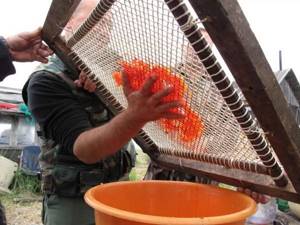
This is how caviar is cleaned in production
How to properly remove a jast at home
- We wash the caviar in the film with cold water.

It is better to wash caviar under running water
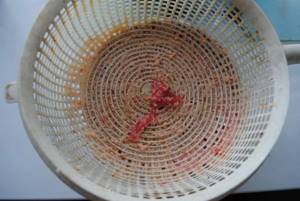
The film remains on the surface of the sieve
The method is used for cleaning pike, sturgeon, and salmon caviar. It is convenient and easy to use.
What tools do we need?
For different methods of cleaning caviar from film, we will need:
- Fork;
- whisk;
- mixer;
- gauze;
- boiling water;
- a sieve with large cells;
- grater;
- beach badminton racket.

Indeed, you can rub salmon, chum, and salmon caviar through a racket
Before you begin to remove the eggs by any means, the caviar must be thoroughly rinsed under running water.
Main stages of work
- Preparing caviar: washing in water.
- Cleansing caviar from the rind.
- Salting of the purified product.
How to revive over-salted red caviar
Place the caviar in a vase or saucer. It is ready for use.2 Caviar that has a foreign odor can be removed. Brew strong tea leaves in any container. Strain the brewed liquid, separating it from the tea leaves. The tea leaves are not needed, throw them away. The brewing temperature should be no more than 30-35 degrees so that the caviar simply does not cook in it.
Pour the strained tea over the caviar at the rate of one part caviar to one part brewed tea, or one part caviar to two parts tea, depending on how strong the smell is. Rinse in the tea leaves for 5-7 minutes, stirring gently so that the eggs do not burst. Strain the caviar through cheesecloth or a sieve and let it drain. There is not enough evil, such a product was ruined in a day. Threw it out of course... Utro-na-More Tuesday, 13·05·2008, 23:41 Message #6 Profile options: Very active memberGroup: Regular memberMessages: 2655Registration: Tue,·07·12·04On the forum: Sun,·21·09 ·14From: MoscowThanks:
Awards: 5Rating: 18 hmm. guys, we had the same story. True, the scent was not strong and the taste was absolutely normal, but see Lilia’s post... However, either the toad strangled it, or they were just lazy and left the jars on the balcony (it was cold). And oddly enough, after a while the smell disappeared, and the caviar just became a little saltier.
They ate it all! (although I didn’t – I can’t stand too much salt). And my relatives also say that when we sent them parcels with caviar from Magadan, the caviar rarely arrived without a flavor. And they always ate everything and that - it’s not us, spoiled northerners.
Not a guide to action(!), just a fact. Or throw it away without risk? liliya Monday, 12·05·2008, 20:06 Message #2 Profile options: Very active participantGroup: SupermoderatorMessages: 1959Registration: Wed,·17·11·04On the forum: Sat,·28·01·17From: Italia, MilanoThanks:
Rating: 21 Throw it away. Violation of food storage conditions results in a sharp increase in pathogenic bacteria, the waste products of which emit this unpleasant odor. You can be seriously poisoned. I wouldn't risk it, it's not worth the trouble. restorer zlata Tuesday, 05/13/2008, 11:16 Message #3 Profile options: thing-in-itselfGroup: SupermoderatorMessages: 2388Registration: Thu, 07/14/05Forum: Thu, 11/30/17From: Blagoveshchensk, Amur region. Acknowledgments:
Awards: 3Rating: 45 Just for the future. Caviar can be frozen for long-term storage.
Pack in small containers - you can eat as much as you want at a time and store in the freezer.
How to quickly and effectively clean caviar from film
We have already talked about the classic method of rubbing caviar through a sieve. Let's try other cleaning options.
A whisk and boiling water will remove the film
- Pour cold water into a large saucepan.
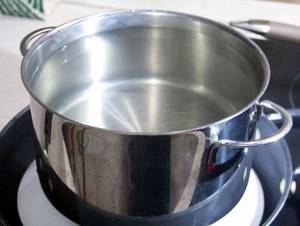
Pour cold water
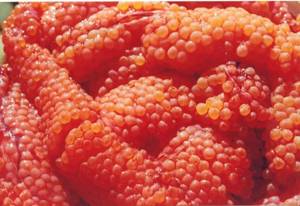
Only 2 bags of caviar can be placed in the pan
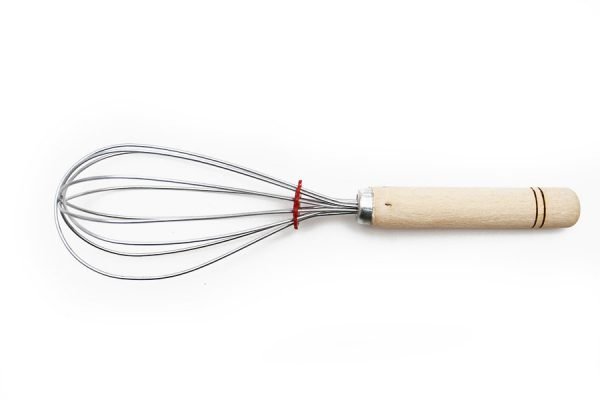
Whisk the caviar in boiling water
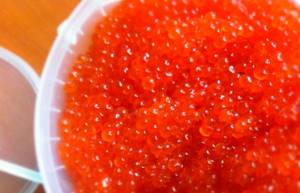
The product is ready for salting
When using this method, it is important not to cook the caviar. Therefore, you need to act very quickly and carefully.
Remove films with a regular grater
In addition to the whisk, you can use a kitchen grater for small caviar (pike, crucian carp, perch, trout caviar).
- Using a coarse grater, grate the caviar in the film. We try to act carefully so as not to crush the eggs.
- The peeled ashtick remains on the surface of the grater. We throw it away.
- Add 1 tbsp caviar. l. salt and add hot water.
- Stir and leave for 20 minutes.
- Strain through a fine sieve. If there are small particles of film left in the mixture, remove them with a fork.
- There is some liquid left in the caviar, so leave it in the sieve for 10 minutes to let the water drain.
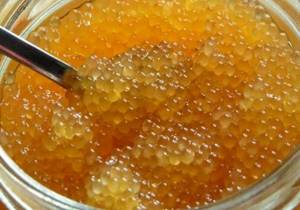
Our product is ready to be cooked
Video: Cleaning caviar with a grater
Cleaning caviar using a mixer
- Place the bag of caviar in the pan.
- We set the mixer to the minimum speed setting.
- “Whip” the caviar without pressing the nozzle, carefully moving along the film.
- We clean off the remaining eggs on the eggshell with our hands or a fork.
Features of caviar processing
- Before removing the oysters, red caviar must first be rinsed in a saline solution: for 1 liter of hot water we need 0.5 teaspoon of iodized salt. For black and river fish caviar such processing is not required.
- Dry the caviar by spreading it on a sieve or gauze at room temperature.
- Do not dry the purified product on paper napkins and towels, as the caviar will quickly stick to them.
- Experts advise not to fry peeled caviar, as it becomes hard, and suggest salting it.
- To salt caviar, if we are going to use it quickly, it is not at all necessary to keep the product in salt for several days. It is enough to soak the caviar in brine for 7–10 minutes: 2 tablespoons of salt per 1 liter of warm water. Dry and pour with sunflower oil.
- If we plan to store caviar in the refrigerator for more than 14 days, then we keep it in brine for 30 minutes.
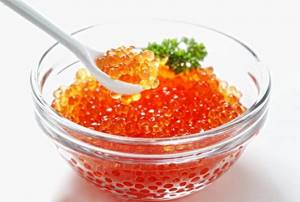
Caviar is salted quickly, within 10–30 minutes
A pleasant surprise in the form of caviar when cutting fish will definitely please you now. After all, the methods we described will greatly facilitate the housewife’s work. Now crumbly homemade caviar on the festive table will surprise guests not only with its great taste, but also with its no less brilliant appearance.
The modern seafood retail market has long stepped forward compared to even the last decade, and now in a regular supermarket it is not difficult to purchase good pink salmon or other noble fish, almost freshly caught. It’s especially nice when, as a result of such “shopping fishing,” you get a fish with caviar. However, the inexperienced “fisherman” has a question: how to clean the caviar from the film? How to prepare it for subsequent salting?
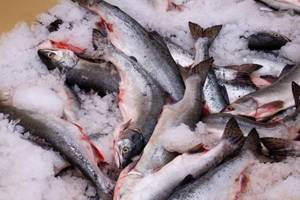
Hot salting
We offer harmless hot salting of fresh caviar. You can be sure that there will definitely be no parasites in it.
Required ingredients:
- Fresh pike caviar – 300 g
- Salt - tablespoon
- Garlic – 1 clove
- Water – 1 liter
It takes 30 minutes to prepare the products. Cooking – 30 minutes – 1 hour.
- Carefully remove the caviar from the crust.
- Set the purified product aside.
- Pour a liter of boiling water into a suitable container.
- Add salt to the water and stir. Allow to cool to 80 C.
- Add caviar to the water and stir for 7-10 minutes. Caviar at this time becomes brighter and richer.
- Rinse the caviar under water and strain through cheesecloth.
- Tie the gauze so that the eggs remain inside. Tie gauze to the tap to drain all the brine.
- After 2 hours, transfer the product into a bowl, squeeze out a clove of garlic - the taste will be very interesting. Place in the refrigerator for half an hour. After a while, the caviar looks crumbly and acquires color. This is exactly what you can usually see in the photo - beautiful, expensive in appearance. You can make sandwiches with caviar and butter or freeze it - thus preserving it from spoilage.
Number of servings – 3. KBJU of the whole dish: proteins – 85.3, fats – 5.7, carbohydrates – 0.5, calories – 394.3.
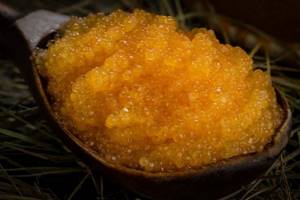
Choosing fish in the store
The first step is to choose a good “catching sample”. Here are the 5 main signs of a suitable specimen:
- The fish, of course, must have an obvious sign of the presence of caviar: a noticeably thick “belly”.
- Pay attention to the eyes - in good fish they will be transparent both fresh and frozen.
- Of course, the fish should not emit an unpleasant pungent odor, but it should smell, one might say, of the sea.
- If you take a fresh carcass, then pressing on its side should quickly remove the dent. In other words, the fish should be quite elastic.
- Another important sign of a quality product is red, loose gills.
Why do the calves get bigger? causes of full calves and options for making your calves thinner.
The first reason is swelling of the legs and ways to eliminate the problem.
Whether there is swelling of the legs is quite easy to find out. You just need to see if in the evening there are traces of the elastic bands of the socks on your ankles. You can also simply press your finger on the foot in the dry bone area. If pressure leaves a hole that gradually disappears, swelling is present. And healthy, swelling-free tissues are elastic, they immediately restore their shape
Swelling can be managed with a diet that excludes salty and fatty foods, as well as using diuretics. A simple piece of advice can also make you feel better: when going to bed in the evening, place a small pillow under your feet. And during the day, if possible, lie down on the sofa, throwing your legs up on a wall or elevated surface.
Attention! Only if your swelling does not go away, be sure to visit a doctor, as this may be a sign of a serious illness. When the swelling goes down, you can give beautiful relief to your calves with the help of physical exercises, step - aerobics and running. The second reason is excess weight and correction of calves at the same time
The second reason is excess weight and correction of calves at the same time.
Only if the volume of your calves is increased due to excess weight, you need to go on a diet, start eating right and include in your complex of physical exercises those that are designed specifically to work on this area. So, how to make your calves smaller? For example, you can go swimming, jogging, or do simple exercises for your calves: walk up the stairs, stand on your toes, using a step platform or other elevation (box, threshold, etc.), jump rope, walk more or bounce On the socks.
Reason three: pumped calves and how to fix the problem.
The most severe case is if the calves are large in volume due to the fact that they are pumped up due to overly intense sports activities. There are unlikely to be effective methods that can bring results quickly. How to reduce calves in this case? Here we can recommend reducing the overall load on your legs and limiting your intake of protein foods.
In addition, you will have to exclude sweets and fatty foods in order not to gain weight, therefore, you will have to eat only vegetables and fruits. You can periodically stretch your calf muscles. To do this, you need to sit down, raise your legs straight, first pull your foot towards you, then away from you. This way you can slightly change the shape of your calves, making them more elongated and visually reducing their volume.
Recommendations and exercises from fitness trainers to reduce calves.
N.p. - you need to stand up straight, and put your legs hip-width apart, and your feet parallel. First inhale, and as you exhale rise up onto your toes. Repeat 25 times.
Exercise 2. Raising on your toes on one leg.
N. p. - stand up straight again, transfer your entire body weight to your right leg, while lifting your left leg off the floor, bending it at the knee. First, inhale, and as you exhale, rise onto your toes. Repeat for each leg 15 times.
Exercise 3. rise on toes with toes inward (with “clubfooted” feet).
N.p. - again stand up straight, place your feet at the width of your pelvis, point your toes inward. First, inhale, and as you exhale, rise up onto your toes. Repeat 25 times.
Repeat the entire sequence of these exercises twice.
To reduce your calves by two to three centimeters, the duration of training is at least six months.
Some more exercises for those who are wondering: “how to reduce calves? Exercise 1. Sit on a small mat on your knees, keep your back straight and your arms straight in front of you. In this position, sit on the floor alternately on the left and right sides of the thighs, do it while you have the strength.
Exercise 2: A good exercise for your calves is to stand on a small hill so that your heels hang down. Raise on your toes and lower on your heels at this height.
Exercise 3: calf stretch. Take a step forward with one leg, while placing your palms on your buttocks. Slowly bend your front leg at the knee and gradually squat forward and down, deeper and deeper, while stretching the calf muscle of the back leg and the back of the thigh. If you want to increase the stretch, you can move your front leg a little further, just don't put your hands on it.
In this exercise, the main weight should always fall on the back leg.
Performing these exercises will not be difficult, but at the same time the calf muscles dry out, and the shape of the legs changes and begins to look very feminine. Fitness@Funny. Health Funny Health * health? Be healthy!
Removing caviar from the carcass
So, your pink salmon has successfully made its way from the store counter to the kitchen. Where to begin?
- If you took frozen fish, then let it defrost completely, but do not keep it at room temperature. A carcass weighing a couple of kilograms will defrost for 3–5 hours at normal temperature - after which even slightly frozen fish can begin to be cut.
- First you need to rip open the belly of the pink salmon, starting from the head and ending with the anus. Do not dig the knife too deep so as not to damage the section with caviar and insides and not to stain everything with blood.
- Then, using the same knife, we slightly separate the caviar from the side walls by simply inserting the knife between the wall and the bag of caviar and slightly bending it to the side. This procedure must be done on both sides of the bag.
- Now you should separate the bags of caviar and entrails from the fish carcass. The bag and entrails are located quite tightly and are attached to the carcass in two places: next to the anus and near the head. Feel the attachment points with your fingers and separate them either with a knife or with gentle finger movements. This comes out quite easily.
The bag with pink salmon caviar is actually two independent bags, between which all the other insides of the fish are located.
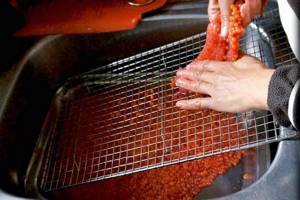
Separating caviar from film: two ways
The first method involves using a special sieve with large cells:
- The separated bags of caviar must be carefully ripped open using your fingers.
- Next, we arm ourselves with a tall glass, where we place the ripped bags of caviar.
- We insert a sushi stick into the glass and quickly move it in a circular motion along the caviar with the film. The film will gradually wrap around the tip of the stick. For best results, it is recommended to alternate the direction of movement of the stick.
- Then we take a sieve with round holes, which will be slightly larger in size than the eggs. Place the contents of the glass in a sieve and rub the eggs through the sieve with the palm of your hand, freeing them from any remaining film.
- We also put the film that is wound on a wooden stick into a sieve and, using the same movements with the palm of our hand, remove the remaining eggs from it.
Don’t be afraid to separate the caviar from the film in this way: the eggs of any red fish - pink salmon, trout or salmon - when fresh are quite elastic and will easily pass through a sieve without bursting.
If there is no special sieve, some homemade caviar lovers recommend using a badminton racket instead.
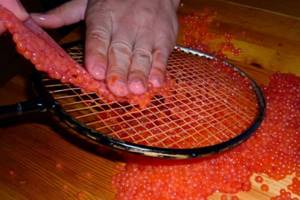
The second method of separating caviar from the film will appeal to those who trust heat treatment to avoid the appearance of parasites in products.
- After separating the bags of eggs from the fish and entrails, place them in a sieve with small holes - for example, the one through which flour is usually sifted - and boil water.
- We place the sieve on a deep bowl and pour boiling water over the caviar with film in small portions, stirring it immediately with a fork or spoon. It is important to spray with hot water in those places where you see the appearance of a curled film. Stirring quickly and intensively is also important: this way the eggs will not cook, will not burst and will remain intact, and the hot water will quickly drain through the sieve into the bowl.
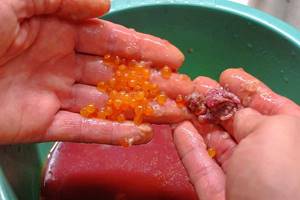
In 3-4 passes you can scald almost all the film that was on the caviar and remove it with a fork.
We study the color and size of red caviar eggs depending on the type of fish
- An anadromous fish from the salmon family is chum salmon. Produces the largest red caviar. On average, this is a range from 5 to 7, and sometimes up to 9 mm. Because of this, it is often used to decorate dishes. This caviar has an almost even round shape and a fairly pronounced embryo spot. The color is a calm orange with amber notes.
- caviar is also quite large , but very rare. The diameter ranges from 5.5 to 7 mm. The taste of this caviar is bitter and even has a hint of pungency. Because of this, it is considered a real delicacy for gourmets, since many people find this taste very specific. The color is more red in color with a high degree of saturation.
- The most popular caviar is from pink salmon. It has eggs up to 5 mm in diameter, which are almost equal in size. Color ranges from light orange to long-lasting shade. Their shell is less durable than previous options. It has a universal taste, which is why many people love this caviar.
- Sockeye salmon caviar has a smaller diameter – 3-4 mm. But it is extremely rare on the Russian market due to the high price, mass extermination and main location in the latitudes of Alaska. The color of this caviar is red and much brighter than that of other representatives.
- The healthiest caviar is coho salmon, but again, due to its bitter taste, it is not so popular. Diameter up to 3 mm, color – bright orange.
- Trout caviar is considered the smallest - 2-3 mm. But it has the widest color spectrum from light orange to rich color with amber notes. Has a pronounced salty taste.

Comparison
Salting caviar
That's all! As you can see, there is not much hassle with caviar, and the work does not require a lot of time. In this sense, red fish can be an excellent “springboard” for getting your feet wet in the business of preparing fish caviar at home, so that you can then move on to more complex cases - for example, pike caviar.
Salting is a completely simple process. Typically, about 1–1.5 teaspoons of coarse salt are used for 200 grams of caviar.
To make sure that there is not too much salt and not too little, you can taste the caviar with salt right during salting.
We transfer the salted product into gauze, collect it in a bag and hang it over a small tray for about an hour to remove excess moisture.
"Five Minute"
How to cook pike caviar not only easily, but also quickly? The following recipe is suggested. The big advantage of “five minutes” is that in such a short time the dish has time to be fully prepared, and all the beneficial properties are preserved.
Required Products:
- Caviar – 500 g
- Water – 2 l
- Salt – 4 tablespoons
Preparation of ingredients – 5-10 minutes.
Steps:
- Cut the caviar into small pieces and immediately place in a suitable sieve. The holes in the sieve should be large enough for the caviar to pass through easily.
- Wipe the caviar; only films should remain on top of the sieve.
- Now you need to prepare the brine. Boil the water and let it stand for 10-15 minutes.
- Add salt to slightly cooled water.
- Rinse the eggs with cold water. To do this, place the caviar in a bowl, add water and stir gently. This must be done so that the caviar rises up and is thus washed. Drain the water. Repeat the process several times until the water looks clear.
- Place the washed caviar in the brine for 5 minutes, stir lightly, after a while the water must be carefully drained.
- Take gauze folded in several layers, or a piece of fabric that will allow water to pass through well, and place it in a colander. Place the caviar in a colander so that all the liquid drains and is absorbed into the fabric.
- Transfer the dish to a bowl. If it turns out to be salty, you need to quickly rinse with cold water. If it’s the other way around, add a little salt to taste.
- Using a fork, mix the eggs thoroughly and beat lightly. You should get a white foam.
- Add a little olive oil and stir again.
- Prepare clean, dry jars to preserve the food. “Since pike caviar is a seasonal product, you can take small portioned jars and freeze them. But you need to remember that you need to defrost it in the refrigerator and only once.”
- When the caviar sits in the refrigerator for some time, it will become even tastier as it “infuses.”
Number of servings - 5. Total amount of proteins - 142, fats - 9.5, carbohydrates - 0, calories - 653.5.

How to quickly and easily peel pink salmon caviar from the film
Before cleaning, caviar in eggs must be washed with running water. After preliminary preparation, the bag must be placed in a colander for a few minutes to drain all excess liquid with remaining blood. After this, you can remove the membrane in any convenient way.
Using a whisk and boiling water
Pour water into a saucepan and bring to a boil. Pour salt into boiling water in proportions of 1 tbsp. l. per 1 liter of water and mix well. When the water has cooled a little, put the jar in it and whisk gently with a whisk.
Movements should be light, not fast, so as not to damage the product. When all the caviar film is wrapped around the whisk, drain the water through a colander or sieve. Rinse red caviar with cold water and salt.
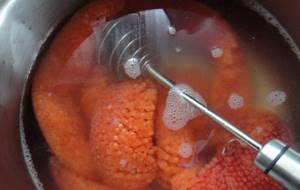
Remove with a mixer
This method is suitable for cleaning large quantities of product. To clean the caviar from the film, you need to place the caviar in a convenient bowl and turn on the mixer to the minimum setting. The nozzle does not need to be lowered into the middle of the bag; movements should be smooth, along the edges. Remove the remaining film by hand.
For work, “snake” attachments are used.
Remove with a spoon
A simple and quick method that is suitable for cleaning large quantities of product. To clean pink salmon caviar from the film, you will need a colander and a wooden spoon:
- Place prepared yastyki in a bowl and rinse with hot water.
- Insert a spoon between the bags and quickly rub your palms along the handle.
- The film will collect on the spoon until all the eggs are released.
If the fish was frozen, the fish can be filled with boiling water. In this case, it will be enough to peel back part of the curled film and remove the caviar with a spoon. The cooled product should not be poured with boiling water, otherwise the eggs will harden.
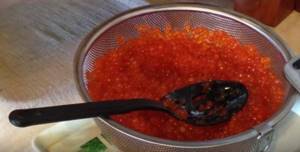
Remove films with a regular grater
To work, you will need a grater with large teeth and a fine sieve. Any sturgeon caviar in film is cleaned using this method:
- Place the grater in the sieve at a slight angle.
- Cut the yashtik with a knife on one side and grate it. You need to act carefully, without pressing the eggs too hard to the surface.
- Remove the film and remove the residue by hand.
- Rinse the cleaned caviar and let the water drain.

Clean the caviar using cheesecloth and a fork
The method is suitable for cleaning both fresh and defrosted products.
To remove the membrane shell you will need:
- 2 bowls;
- gauze or wide bandage (small piece);
- fork.
To prepare the product for salting, you need to perform the following steps:
- Pour cold water into one bowl, boiling water into the other.
- Fold the gauze into 2-3 layers and place it on a flat surface.
- Wash the yashtik, dry it slightly and cut with a knife from one edge.
- Place the prepared bags on gauze, wrap and gather the edges of the fabric on top.
- Place the bag into the bowls one at a time, starting with boiling water. Mix well with a fork until the curdled shell begins to wrap around the cloves. Leave in cold water for 1-2 minutes. Stir again with a fork to remove any remaining membrane, then remove and place on the counter.
- Collect the eggs with a spoon.
If the gauze has absorbed a lot of liquid, you can hang the bag over the sink for 10-15 minutes. This method can be used for pickling. In this case, the purified product will need to be dipped directly into the gauze into a saline solution.
To clean caviar, do not use metal utensils. Wooden spoons and forks, plastic or glass bowls work best. The water must be clean and filtered, otherwise the taste of the finished delicacy may deteriorate.
How to separate trout eggs from film: home cleaning methods
Before you start salting red caviar, you need to clear it of the film (yastyk). You can do this in any way convenient for you: either manually or using improvised means. We offer you 3 of the easiest and fastest ways to clean caviar at home.
Method No. 1: cleaning in a “sleeve” of gauze
We form a kind of “sleeve” from gauze (we use multi-layer gauze for this). We close the “sleeve” on one side, then pour the caviar into it.
We thoroughly wash the eggs with water, as a result of which the film is washed off from them.
Method number 2: cleaning in hot brine
A very effective cleaning method that does not require much effort, but has its own nuances.
- To free fresh caviar from films, you first need to boil water, mix it with salt (3 tablespoons per 1 liter of water), and cool slightly.
- After this, you need to pour the prepared brine over the eggs, cover them with a lid and leave them to “soak” for 20 minutes. During this time, the film will change, becoming more loose.
- Now you can proceed to the next stage of cleaning - take a whisk (or, in extreme cases, a fork) and begin stirring the caviar in the brine. Beat thoroughly, but carefully, so that the eggs are broken, but the eggs themselves remain intact. The movements need to be made in a circle, in one direction, so we form a funnel, thanks to which the film will begin to wrap around the rim.
- When most of the eggs are cleaned, we transfer the mass into a sieve and let the brine drain from the eggs.
- Then we put it in portions on a napkin (or paper towel), cover it with a towel on top and start wiping the eggs. We do everything carefully so as not to damage them.
As a result, the remnants of the eggs are removed and we get crumbly, dry (in other words, granular) eggs. As you can see, cleaning in this way directly combines the salting process itself.
It is very important to monitor the temperature of the brine when using the hot cleaning method. If you put red caviar in too hot a liquid, the eggs will simply cook.
It’s easy to check that the temperature is correct - throw 1-2 grains into the brine, if they practically do not change color, then the temperature is good. But if the thrown eggs fade, it means the liquid is still hot, give it time to cool.
Another important nuance - do not rinse the eggs with cold fresh water, as this will cause them to lose their elasticity and become hard.
Method number 3: cleaning by hand or through a colander
It is quite possible to clean caviar with your own hands, without using unnecessary additional means. To do this, you just need to break the yastik into several parts, and then start taking out a grain of red caviar from it with your hands (or a fork).
You can try to wipe the broken film with eggs through a colander (with the appropriate hole size), or through a mesh.
See how the cleaning method manually and through a mesh looks in action in a short video.


